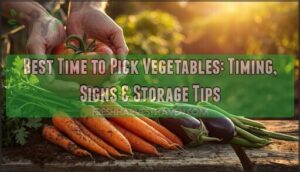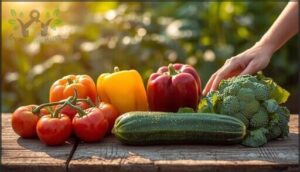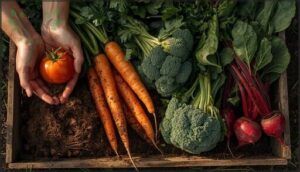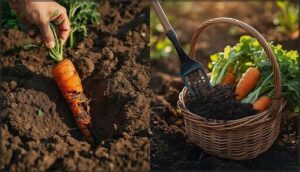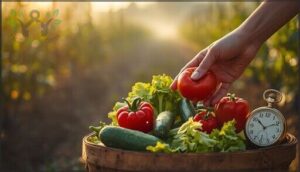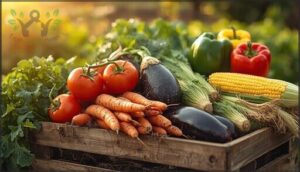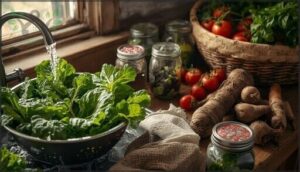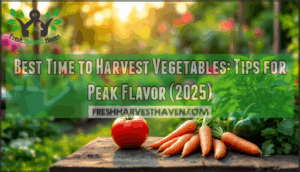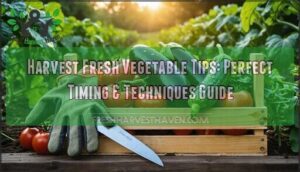This site is supported by our readers. We may earn a commission, at no cost to you, if you purchase through links.
You wait all season for the perfect tomato, only to pick it a day too late and find it split and overripe. Or you harvest those carrots a week too early, and they’re thin and tasteless. The best time to pick vegetables isn’t marked on any calendar—it’s written in the plants themselves.
Temperature swings, soil fertility, and even the hours of daylight your garden receives all shift when your crops hit peak flavor and texture. Miss that narrow window, and you’re eating disappointment instead of the harvest you worked months to grow.
Learning to read these signals turns guesswork into precision, so every vegetable you pull from the ground arrives at your table exactly when it should.
Table Of Contents
Key Takeaways
- Harvest timing depends on multiple factors working together—temperature swings, soil fertility, daylight hours, and weather patterns all shift when crops hit peak flavor, often creating windows as narrow as 24-48 hours.
- Early morning harvesting captures up to 30% more moisture and flavor than midday picks because plants rehydrate overnight, making produce crisper, sweeter, and more shelf-stable.
- Each vegetable type shows specific ripeness signals you can read: tomatoes at the breaker stage (half green, half pink), broccoli at 6-7 inches with tight buds, carrots when shoulders reach ¾ to 1 inch wide, and beans when pods snap cleanly before seeds harden.
- Immediate post-harvest handling determines storage success—cooling crops fast (ideally below 40°F), avoiding washing until use, and keeping ethylene producers separate prevents the 40-50% spoilage rate that ruins harvested vegetables.
Key Factors Affecting Vegetable Harvest Timing
You can’t control when a vegetable is truly ready to harvest unless you understand what drives its growth and ripening. Several environmental and biological factors work together to determine the perfect picking window.
Let’s look at the key elements that affect your harvest timing.
Climate and Weather Conditions
Temperature fluctuations and weather patterns shape when your vegetables ripen. A 1°C shift in growing season temps can increase yield swings by 4–6% for many crops.
Climate change brings more extreme heat and rainfall impact, forcing you to watch harvest timing closely. In your climate zone, sudden heat waves or heavy rain shrink the ideal harvest window—sometimes to just 24–48 hours.
Understanding weather forecast systems is vital for maintaining ideal harvest timing.
Soil Health and Fertility
Your soil’s nutrient levels directly influence when your vegetables mature and how quickly they ripen. Fields with strong soil health—rich organic matter, active soil microbes, and balanced nutrient cycling—produce crops that reach harvest readiness faster and more uniformly.
Here’s what drives soil fertility in your garden:
- Organic matter boosts yields by 12% for each 1% increase
- Fertilizer types matter—semi-organic systems increase yields 29% over unfertilized soil
- Crop rotation and soil preparation improve fertility with a 19.5% positive effect
Soil science shows that soil management practices like adding organic amendments improve nutrient availability. Sandy soils leach nitrogen quickly, delaying maturity in 30% of crops. Clay soils respond best to fertility inputs, showing 24.6% yield gains compared to lighter soils. Understanding soil composition is essential for optimizing soil fertility and overall garden health.
Vegetable Variety and Maturity Dates
Crop selection shapes your harvest timing more than most gardeners realize. Bush beans mature in 46–65 days, while tomatoes need 65–100 days. Radishes sprint to harvest in just 22–40 days.
Maturity charts on seed packets guide your planting schedule, but variety research matters—’Marketmore 76′ cucumbers take 67 days direct-seeded versus only 46 days transplanted. Growth tracking against these maturity dates keeps your harvest calendar accurate.
Day Length and Light Exposure
Daylight hours control more than just plant growth—they trigger flowering and bulb formation through photoperiod effects. Long-day vegetables like onions need 14–16 hours of light exposure to form bulbs, while short-day plants flower with 11–12 hours. Most crops halt growth below 10 hours daily.
Understanding these light requirements lets you time vegetable harvesting for peak maturity and adjust planting schedules using supplemental lighting or season selection.
How to Tell When Vegetables Are Ready
You can’t just guess when your vegetables are ready—you need to know what you’re looking for. Each crop has its own set of visual and physical cues that tell you it’s reached peak ripeness.
Let’s walk through the key signs to watch for, how timing shifts by vegetable type, and the mistakes that can cost you flavor and quality.
Signs of Ripeness: Color, Size, and Texture
Your vegetables tell you they’re ready through three reliable ripeness indicators. Color changes happen first—tomatoes shift from green to red as they ripen, while peppers develop their glossy finish.
Size measurements matter too; broccoli heads should reach 6-7 inches across.
Texture tests seal the deal: gentle pressure reveals firmness in summer squash and softness in ripe avocados, helping you nail harvest timing for peak flavor.
Timing by Vegetable Type
Each vegetable variety follows its own harvest schedule based on growth stages and maturity dates. Matching your harvest timing to the vegetable type you’re growing ensures peak flavor and texture:
- Tomatoes reach the breaker stage at half green, half pink—perfect for off-vine ripening
- Carrots mature in 42-56 days, depending on variety
- Broccoli needs cutting before yellow buds open
- Snap beans ripen in 50-60 days when pods fill out
- Beets hit ideal size at 1¼ to 2 inches across
Common Mistakes to Avoid
Many gardeners miss the narrow window between perfect and past prime. Waiting too long robs you of sweet, tender produce—peas and beans lose flavor fast, while carrots harvested beyond 12 weeks turn woody. Using the wrong harvest method causes crop damage too. Tearing vegetables instead of cutting with sharp tools invites disease and weakens plants.
| Mistake | Impact | Better Approach |
|---|---|---|
| Harvesting during midday heat | Wilting, flavor loss | Pick early morning after dew dries |
| Pulling root crops forcefully | Broken vegetables, damaged roots | Loosen soil first with garden fork |
| Ignoring daily checks | Overripe produce, reduced yields | Monitor vegetable ripening closely during peak season |
| Rough post harvest handling | Bruising, spoilage | Use gentle vegetable handling and proper storage methods |
Proper harvest timing and harvest techniques protect your crop’s quality from garden to table.
Best Time of Day to Harvest Vegetables
The clock matters more than you might think for harvesting your vegetables. Pick at the wrong time of day, and you’ll end up with wilted, less flavorful produce that won’t store well.
Let’s look at why timing your harvest right makes all the difference in quality and shelf life.
Why Early Morning is Ideal
Ever notice how dewdrops cling to your garden at dawn? That’s your cue. Harvesting vegetables in early morning captures peak flavor and crop moisture—up to 30% more water content than midday picks.
Morning dew signals peak harvest time—vegetables hold 30% more moisture and flavor at dawn than midday
Your plants spend the night rehydrating, making them crisper and sweeter. This harvest time reduces plant stress, extends shelf life, and locks in nutrients before the sun starts working against you.
Impact of Temperature and Sunlight
When daytime temps climb above 92°F, your harvest time matters more than you think. Heat stress literally cooks produce on the vine, while sustained temperatures over 90°F trigger flower abortion and delay fruit set by weeks.
Sunlight intensity drives photosynthesis rates—lettuce thrives at 240–300 μmol·m⁻²·s⁻¹—but excessive exposure causes sunburn and splits.
Temperature thresholds and climate variability directly shape your vegetable harvesting success and crop management strategy.
Tools and Techniques for Gentle Harvesting
Your choice of harvesting methods determines whether you damage plants or preserve them for continued production. Sharp bypass pruners make clean cuts on tomatoes and peppers, while harvest knives shaped like small sickles work perfectly for greens and herbs.
Twist beans and summer squash off gently—pulling stresses stems. For root vegetables, loosen soil with a garden fork first, then pull carefully to avoid breakage.
Precision tools and gentle handling techniques boost harvest efficiency while protecting crop quality.
When to Harvest Popular Garden Vegetables
Each vegetable has its own harvest window, and knowing when to pick makes all the difference in flavor and texture. The signs vary widely—what works for tomatoes won’t apply to carrots or kale.
Here’s how to tell when your most common garden crops are ready to harvest.
Fruiting Vegetables: Tomatoes, Peppers, Squash
When your tomatoes show their first blush of color—about half green, half pink—they’re ready to pick. This breaker stage ensures peak flavor while preventing frost damage.
Peppers need full size and bright color for harvesting vegetables at their best. Summer squash delivers top vegetable yields when picked young, before seeds harden.
Sharp harvest tools protect plants and boost future crop rotation success in your vegetable gardening efforts.
Root Vegetables: Carrots, Potatoes, Beets
Root crops require different harvest timing than aboveground vegetables. Carrots reach peak quality 60-80 days after planting, when shoulders measure ¾ to 1 inch wide. Potatoes are ready two to four weeks after flowering, while beets need 50-70 days to reach 1.5-3 inches.
- Check soil preparation before pulling—drier conditions prevent damage during harvesting vegetables
- Use proper harvest tools to loosen soil around root depth without bruising
- Monitor harvest timing closely; leaving crops too long causes woody texture
- Plan crop rotation and storage methods before your vegetable harvest begins
Leafy Greens: Lettuce, Spinach, Kale
Unlike root vegetables, leafy greens need quicker harvest timing and different vegetable gardening techniques. Lettuce varieties mature from late April through September, depending on type. Spinach grows best with 37–45 days from planting—harvest before flower stalks appear. Kale harvest tips include picking from 60 days onward, before heavy frost hits. Never harvest when leaves are wet.
These greens’ storage methods and harvesting vegetables strategies preserve leafy green nutrition while following proper gardening techniques.
Brassicas: Broccoli, Cauliflower, Cabbage
Broccoli harvest timing runs 85–100 days after planting—cut when heads are tight and buds stay closed. Cauliflower recipes shine when heads reach firm, compact whiteness at 55–100 days. Cabbage benefits from cool weather; pick dense heads at 70–100 days to prevent splitting.
These brassica farming basics protect peak flavor while proper harvesting techniques preserve broccoli nutrition through careful vegetable preparation and vegetable gardening methods.
Beans and Peas
Fresh beans reach peak sweetness 55–60 days after planting, when pods snap cleanly and seeds just begin forming inside. Snap those pods before seeds harden—timing matters for bean varieties and pea nutrition alike.
Peas deliver best flavor at full pod formation but before seeds lose tenderness. Watch for blossoms; both crops ripen one to two weeks after flowering, making harvest timing essential for seed quality in your vegetable gardening routine.
Tips for Storing Freshly Harvested Vegetables
Getting your vegetables out of the garden is only half the job. What you do in the first few hours after harvest makes the difference between crisp, flavorful produce and limp disappointments.
Here’s how to handle and store your harvest so it stays fresh as long as possible.
Immediate Post-Harvest Handling
What you do in the first hour after harvesting vegetables matters most. Cool your crops fast—hydrocooling or forced-air cooling slows decay and keeps flavor locked in. Handle gently to avoid bruises that invite rot.
Harvest when dry, then rinse and dry thoroughly for moisture control.
Clean your harvest tools and containers regularly—post-harvest sanitation stops pathogens before they start.
Short-Term Vs. Long-Term Storage Methods
When harvesting vegetables, you’ll choose between two storage approaches based on how soon you’ll eat them. Short-term storage—leafy greens kept cool and moist for a few days—suits immediate needs. Root vegetables like carrots bridge both strategies: refrigerate short-term or cure for crop preservation lasting weeks.
Long-term methods like curing onions or drying beans stretch shelf life extension for months through careful temperature management and humidity control.
Preventing Spoilage and Maintaining Freshness
Your harvest time success depends on what happens after you pick. Cool vegetables immediately—ideally below 40°F—to slow respiration and microbial growth. Keep ethylene-producing tomatoes away from leafy greens during storage. Use breathable containers for moisture management, and skip washing until you’re ready to eat.
Check stored produce daily, removing any damaged pieces to prevent cross-contamination. These food preservation methods maintain peak freshness and reduce the 40-50% spoilage rate plaguing harvested vegetables.
Frequently Asked Questions (FAQs)
Can I harvest vegetables after rain or watering?
Wait at least 24 hours after rain or watering before harvesting vegetables. Wet conditions increase harmful bacteria like Listeria by 25 times.
Dry foliage also prevents soil contamination and improves your harvest quality.
How often should I check my garden for ripe vegetables?
Check your garden at least once a week, but increase to daily monitoring during peak season.
Quick-maturing crops like zucchini and cucumbers need frequent checks since they can double in size within 24 hours.
Do vegetables ripen after being picked from the plant?
It depends. Tomatoes and some peppers keep ripening thanks to ethylene production—that’s climacteric ripening.
But most vegetables, like cucumbers and leafy greens, won’t improve after harvesting. Pick them at peak flavor.
Should I wash vegetables immediately after harvesting them?
You can rinse harvesting vegetables right away, but it’s often better to wait. Washing benefits include removing dirt and microbial risks, though moisture can speed spoilage if produce isn’t dried properly first.
Conclusion
Like knowing when to pull a perfectly risen loaf from the oven, mastering the best time to pick vegetables transforms your entire harvest. You’ve learned to read the signs your plants offer—color shifts, texture changes, morning crispness—and how storage extends what you’ve grown.
These aren’t abstract principles. They’re observations you’ll sharpen with each season, turning every trip to your garden into a calculated decision that delivers peak flavor every single time.
- https://extension.illinois.edu/blogs/good-growing/2024-06-28-harvesting-vegetables-when-and-how-pick-your-vegetables-best-quality
- https://fieldreport.caes.uga.edu/publications/C935/when-to-harvest-vegetables/
- https://www.ishs.org/ishs-article/376_20
- https://www.nature.com/articles/s41598-024-62258-x
- https://pubs.nmsu.edu/_h/H216.pdf

